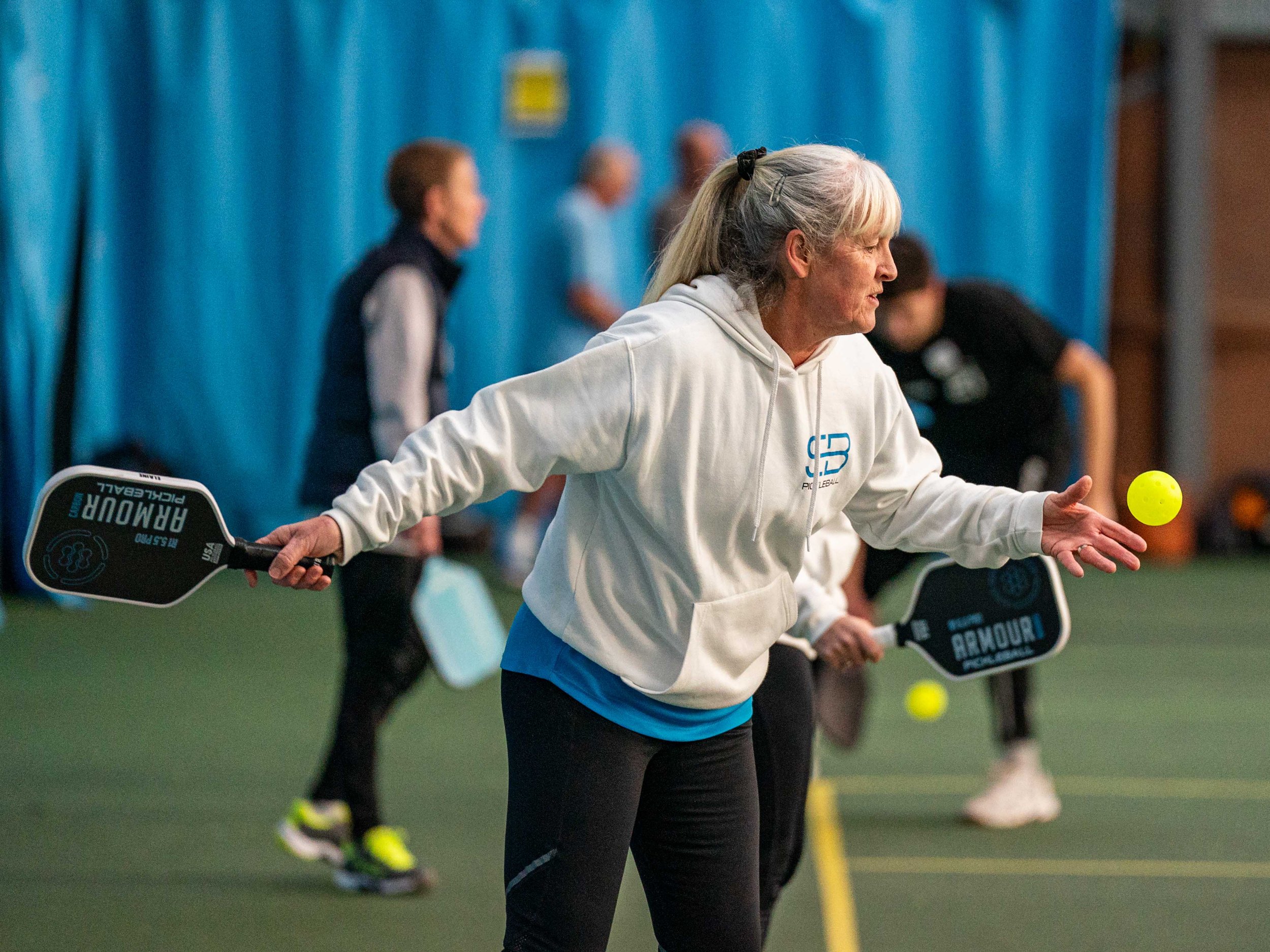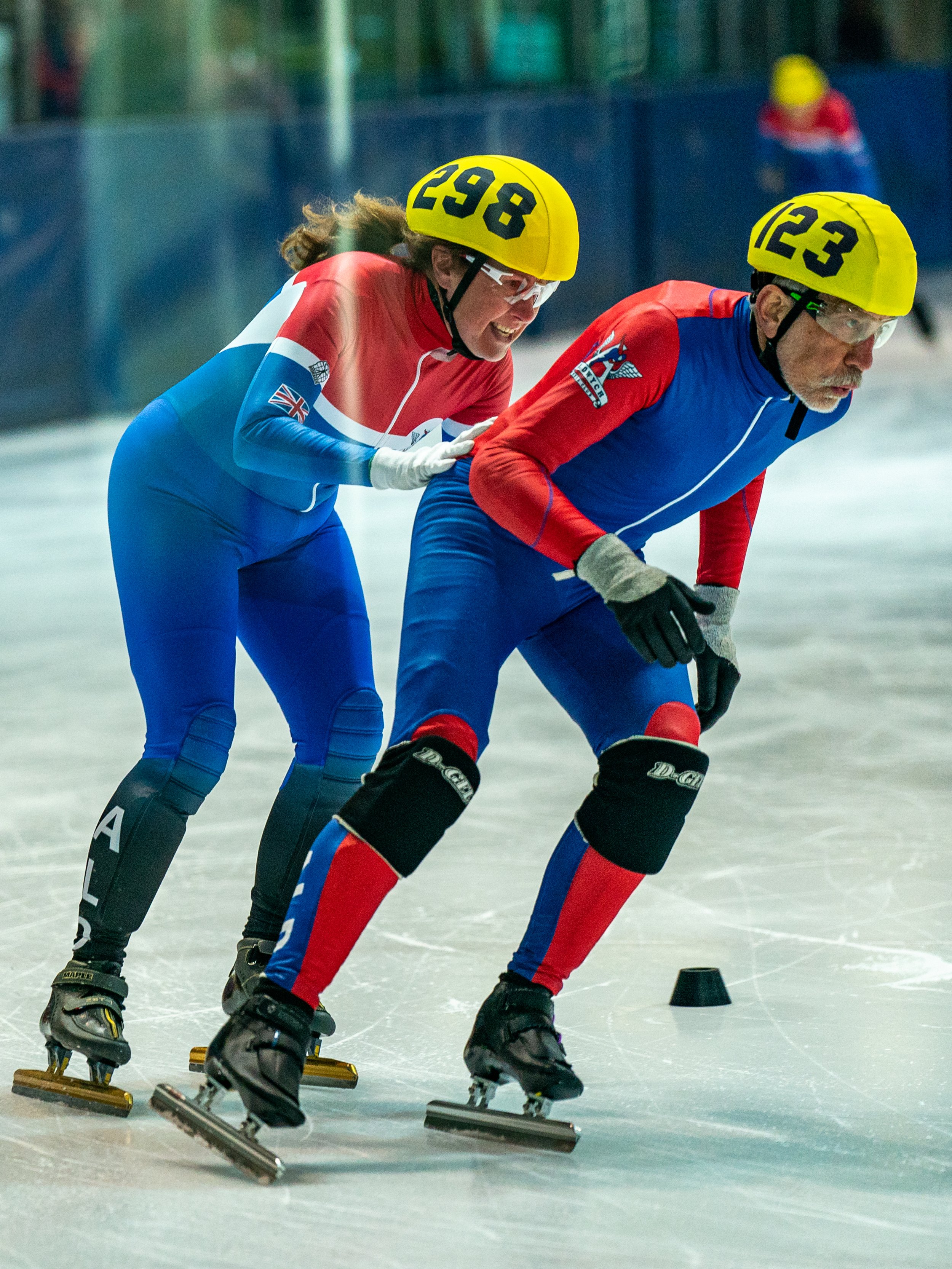My experience of photographing pickleball stems from a day at an indoor festival arranged by Sam Basford, one the leading lights of UK pickleball. Alongside the six festival courts was a Franklin Premier Pickleball League tournament featuring some of the best players in the country, being played on a further four courts – so plenty of high-quality sport to photograph!
As usual, I had done as much research as I could beforehand, including watching some excellent videos on the rules of pickleball (and the scoring system) and looking at what other photographers had produced. I couldn’t find much specifically on how to photograph the sport.
(Sony a9II; 70-200mm at 171mm; f/2.8; 1/1000th sec; ISO 1000)
I took two Sony a9IIs with me, along with two zoom lenses: a 24-70mm f2.8 and a 70-200mm f2.8. I ended up using the longer lens almost all the time. The light in the large hall was very variable, with light patches here and dark patches there, but the cameras coped well for most of the time.
The exception was when some additional lights were switched on as it became darker during the afternoon which, although they made the hall lighter, had a very strange effect on the pictures, with strong banding (see image below). I switched from electronic to mechanical shutter and put the Anti-Flicker feature on and this seemed to resolve the issue.
(Sony a9II; 70-200mm at 100mm; f/2.8; 1/1000th sec; ISO 6400)
I set out my ‘standard’ camera settings in my first blog, 'Getting into Sport and Music Photography' and also in my Sport Photography Top Tips. In the case of pickleball, I generally kept the lens wide open to achieve a shallow depth of field and blur the background, as usual. I used 1/1000th second to freeze the ball and had the ISO set on ‘Auto’, with an upper limit of 8000.
In many ways, photographing pickleball is very similar to tennis. Whereas with ‘contact’ team sports, such as rugby, you get plenty of opportunities to capture opponents with each other, in pickleball it’s difficult to capture opponents – and even partners – together in the same photograph. The image below tries to do just that. I was quite close to the player, so lost the end of the paddle and her feet, but the wide shot does provide some context by showing the hall in which they were playing.
(Sony a9II; 24-70mm at 24mm; f/3.5; 1/1000th sec; ISO 4000)
So, most of the time I found myself photographing individuals. The first problem I encountered was the challenging backgrounds which, unless I managed to position myself so that the player was wholly in front of one of the blue curtains, were very distracting – see the photo below.
(Sony a9II; 70-200mm at 165mm; f/2.8; 1/1000th sec; ISO 5000)
Related to this issue was whether to stand or sit. I normally advocate getting as low as possible because this makes the participants look larger and brings you into the action. I did try this, but the problem was that I was then shooting slightly upwards and therefore exacerbating the distracting background issues by including the top of the blue curtain and the ironwork above (see below).
(Sony a9II; 70-200mm at 200mm; f/2.8; 1/1000th sec; ISO 2000)
As you would expect, I was shooting in ‘continuous high’ and, almost always, I selected the shot where the ball was closest to the player, because this created more drama.
(Sony a9II; 70-200mm at 140mm; f/2.8; 1/1000th sec; ISO 5000)
Pickleball can be extremely fast and there is always the problem that you miss the ideal shot because the ball has already left the frame – see below. This is for the simple fact of reaction time: it takes a while for your eyes to tell your brain to tell your hands to take the shot. So, unless you have ‘Pre-Capture’ technology in your camera, which enables you to ‘go back in time’ before you fully depressed the shutter release, you need to anticipate the action by starting to take your burst just before it happens.
(Sony a9II; 70-200mm at 200mm; f/2.8; 1/1000th sec; ISO 1600)
Bearing all these constraints in mind, my more successful images tended to be taken from behind the baseline towards the far end of the court, so that the net was in the frame. This angle meant that I had the best chance of getting the player’s face straight on, so that they would be instantly recognisable. Below is a standard, stock shot of a player. As already mentioned, either just before or just after the player has hit the ball seems to work best.
(Sony a9II; 70-200mm at 200mm; f/2.8; 1/1000th sec; ISO 3200)
Recognising that I wouldn’t always be able to get a perfect background, I concentrated on getting a good separation between the main subject and the background, as in the photo below. After all, the background provides context and shows the environment, counterbalancing any distractions.
(Sony a9II; 70-200mm at 200mm; f/2.8; 1/1000th sec; ISO 3200)
I also took photographs along the baseline, particularly of serves, thereby providing some variety. In the photo below, the ball has just left the player’s hand, producing some movement to the image.
(Sony a9II; 70-200mm at 200mm; f/2.8; 1/1000th sec; ISO 4000)
This was also a good angle to capture the end-of-game tradition of ‘bumping paddles’, showing a more relaxed side of this highly social sport. Note that the photo below was taken from low down, at net level, which gives it additional impact and intimacy.
(Sony a9II; 70-200mm at 70mm; f/2.8; 1/1000th sec; ISO 4000)
Wherever possible, I try to capture the essence of a sport, including its ‘idiosyncrasies’, so I made sure that I took photos of players leaning forward to avoid encroaching into the non-volley zone, which is something unique to pickleball.
(Sony a9II; 70-200mm at 105mm; f/2.8; 1/1000th sec; ISO 8000)
On the basis that you should always capture reaction as well as action, I am always on the look out for those moments of happiness – or disappointment – that make sport so special to photograph …
(Sony a9II; 70-200mm at 173mm; f/2.8; 1/1000th sec; ISO 6400)
All in all, part of the fun of photographing pickleball is to capture the infectious enjoyment that everybody is having. Why not give it a try?
With special thanks to Sam Basford Pickleball
Read also my Sports Photography Top Tips
If you have enjoyed this blog or if you have any questions/comments, please leave a message in the comments box below.







































